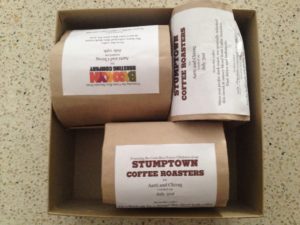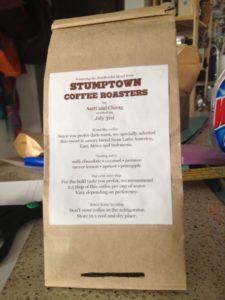CHAPTER 2: OUR FIRST TEST
This is the second in the series of how Driftaway coffee started. You can read the first part here.
So we decided we wanted to start an online coffee subscription for freshly roasted coffee beans. What happened next?
BUSINESS MODEL AND CONSUMER RESEARCH
From our experience working at a marketing agency, the first thing we did was collect hundreds of pages of Mintel consumer research on coffee consumption in the United States. Armed with different colors of highlighters and post-its, we pored through them, trying to understand the coffee market better. We were looking for trends in specialty and whole bean coffee that validated our business idea.
We also started working on our business model. We wrote down the different parts of the business we needed to figure out – sourcing green beans, roasting them, building the website, packaging & shipping. We put this up on dry erase sheets on our wall and wrote down all the questions we had and everything we needed to figure out for each of these.
At this point, Suyog still had a full-time job, while I was on my sabbatical, spending all my time on this. Our weekday evenings and weekends were consumed with this. With a never-ending list of everything we needed to figure out, we were getting a bit overwhelmed. This would take a REALLY long time! But we plowed along.
SWITCHING TO LEAN STARTUP PRINCIPLES
One fine day, Suyog came across this article from AVC that emphasized product-
He realized that we were going about it the wrong way – we needed to quickly create an MVP (Minimal Viable Product), put it in front of people, get feedback and learn from that. Working in a vacuum for months without any real feedback would set us up for failure. And so we decided to create our MVP.
THE MVP

We pasted dry erase sheets all over our tiny apartment. Up first – our initial business idea.
We decided to test our business idea with friends who were in our target market – coffee drinkers that didn’t drink coffee purely for caffeine and drank gourmet supermarket coffee. We offered them free coffee in return for a phone conversation providing us feedback.
Since our business idea was an online coffee subscription of freshly roasted coffee beans, we stripped it down to the most basic elements for this first test.
Instead of a website to place the order -> We used a Google Form asking people how much coffee they consumed and the roast levels they liked.
Instead of sourcing & roasting beans (we didn’t know how to do either yet!) -> we bought freshly roasted coffee beans from amazing Brooklyn roasters.
We then re-packaged the coffee beans and shipped them the day after roasting.
WHAT WE LEARNT FROM OUR FIRST TEST
- No-one was wowed by the coffee
This amazed us. Sure, they liked it – but none of them went, WOW, that’s the best coffee I have made at home. And we expected people to say that – since, in most cases, the participants drank supermarket coffees that weren’t freshly roasted, or as high of a quality as third wave roasters. Yet, neither freshness or quality mattered as much as people’s taste preferences. If they were used to medium roasted coffees with nutty tasting notes, they preferred that over light roasted coffees, even if they were freshly roasted and better quality. Taste trumped everything.
2. It’s difficult to verbalize taste preferences or roast levels.
One person’s “nutty coffee” could be another person’s “bitter coffee”. One person’s medium roast could be another’s light roast. Since coffee companies are not consistent with roast levels, this makes it really tough to truly understand what people mean by a roast level. For instance, one test participant said she liked light roasts, and her boyfriend liked medium. We sent them one light roast and one medium, and turns out she liked the medium roast much more! We started seeing this repeat with a few others, so we then changed to instead sending a variety of 2oz samples, and asking them to choose based on tasting it.

Our test participants responded to the samples really well. For one, it’s hard to try new coffees out at the grocery store without buying big bags, so this was a great way to discover new coffees you might like. Secondly, when you try 3-4 different samples, you think less about whether you liked this new coffee, and instead think about which coffee sample you liked the most.
4. Packaging design matters, even for an initial test
For this initial test, we focused on getting something out ASAP, and didn’t spend any time on designing the coffee labels. Afterall, we were just testing out the business idea. However, on talking to test participants, we realized that, even for a test, that first impression reflected the quality of the product. And when the packaging isn’t designed well, you don’t expect the coffee to taste good either.
OUR CONCLUSION
Armed with these findings, we decided to modify our business idea to a freshly roasted coffee subscription that would be personalized to one’s tastes. And, instead of a quiz, we would start with a tasting kit of four different coffees so people could actually taste the coffees and tell us which kinds they liked.
We decided that our next test would be with coffee beans that we would roast ourselves, a basic website & well-designed coffee labels and packaging. More on that coming soon!


